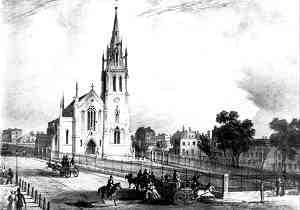
St John's c.1840
St John's Parish was originally part of the ancient Parish of West Ham which covered an area from the River Lea on the West to Green Street (or White Post Lane) on the East, and from the River Thames in the South to Leyton and Wanstead in the North. It was in the diocese of London; in the Archdeaconry of Essex, which stretched from the Lea to the East coast; and in the ancient deanery of Barking, covering the modern London Boroughs of Waltham Forest, Newham and Redbridge, and the Barking half of Barking and Dagenham.
In 1828 Rev. Hugh Chambres-Jones, the Vicar of West Ham (who was also the Archdeacon of Essex), seeing how fast the area was growing, said that there was now an urgent need for a Church building at the centre of Stratford and was granted permission to build a chapel, construction began in 1832.
The land was given by Lord Wellesley-Pole (external link) of Wanstead, elder brother of the Duke of Wellington and of Hon. and Rev. Gerald Valerian Wellesley, Chaplain of the Royal Household, and previously Vicar of West Ham, and Thomas Humphreys, Lord of The Manor of West Ham. The building cost £23,000 to build, of which £5,000 was granted by the church commissioners and much of the rest of the money was given by local people, in 1834 it was opened as a Chapel of Ease for West Ham Parish.
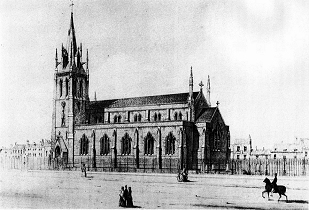
St John's c.1840
St John's was designed by Edward Blore (external link) who was one of the leading architects of his day. Blore was given the job of finishing off Buckingham Palace after John Nash was sacked for being too extravagant. St John's was designed in the Early English style with a tall, ornate south western spire. Interesting architectural features are, externally, the lancets (like stone bridges) and internally the moulded piers (grooves in the pillars) and depressed arches (the tops of the arches are flatter than usual). Edward Blore's original designs are in the Victoria & Albert Museum.
Originally there was a gallery at the back of the Church, which was removed in 1887, and building work in the mid 1990s revealed the bricked-up door which lead from the tower on to the gallery.
The railways reached Stratford in 1839 and five years later London forced its smellier industries to move across the Lea into West Ham, boosting the population of the area tremendously.
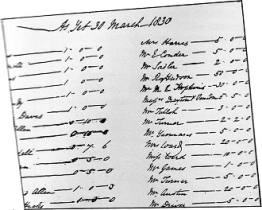
A section from the original subscribers list to the building fund.
In 1844 Stratford became a Conventional District and in 1847, £600 was raised by subscription, for "the purchase of an organ; the erection of a richly carved recedos of Caen stone, extending the whole width of the chancel; in beautifying the altar window with painted glass, at the expense of the Misses Kilner, of Maryland Point, and Mrs Mann, of the Green. These, and other decorations in painted glass, were executed by Mr C Clutterbuck (external link), a resident artist, and are much admired." (Whites Directory for Stratford, 1848 (external link))
One of the famous names connected with St John's is the poet, Gerard Manley Hopkins (external link). He was born in 1844 at 87 The Grove, Stratford. Gerard's family had contributed towards the building fund for the new Parish church. He was baptised at St John's in August 1844. At the age of 22 he turned to Roman Catholicism and two years later began training for the Jesuit priesthood. His profoundly religious poetry earned him a place in Poets' Corner (external link) in Westminster Abbey. In 1994 a memorial to him was unveiled (external link) in Stratford and moved to stand outside Stratford Library when Grove Gardens were removed. The Gerard Manley Hopkins Society held it's first public function at St John's in 1969 (Article in 'The Tablet').
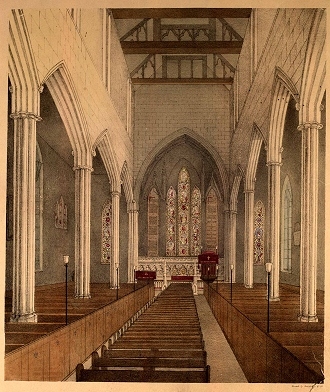
The Interior of the Church c.1851
In 1852, Stratford Marsh, or Stratford-in-the-Marsh, became the first of a number of areas to be separated from St John's. The new Parish church was Christ Church, on the corner of Union Street and High Street. Then in 1865, Stratford New Town, followed Stratford Marsh and also become a separate parish, that of St Paul's (external link).
An Order-in-Council of 29 March 1854 prohibited burials either inside or within 10 yards of the church, or within 2 yards of the churchyard's inclosure. The Order also prohibited the burial of more than one body in any grave, although entries in the burial register show that this provision was not observed. By the 1890s the vicar routinely recorded whether or not graves were full, as burials became increasingly rare. In 1898 he believed that "in all probability the ground would be closed for interments before long", but the order for closure has not been traced. The last recorded burial in the churchyard was in 1922. (SEAX (external link))
In 1868 St John's finally separated from West Ham and became a parish in it's own right.
In 1879, during the incumbency of the Rev William Jay Bolton, the huge 6-sided Martyrs Memorial was built in St John's churchyard to commemorate 23 Protestant men and women who were burnt alive at 'Stratford-le-Bow' in 1556, during the reign of Mary Tudor, for their religious views.
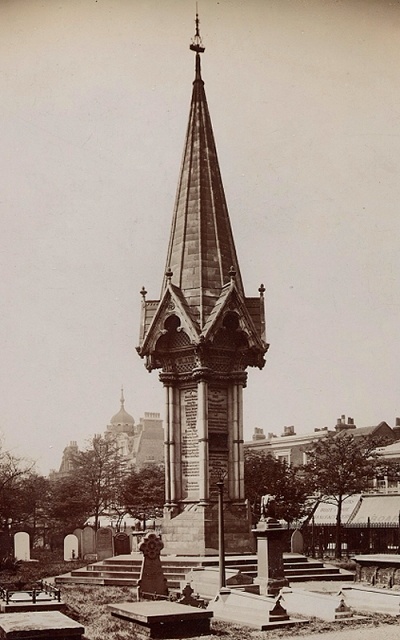
The Martyrs Memorial c.1904
The world's largest docks were constructed on Plaistow Levels & East Ham Levels, the marshes along the Thames, as well as on the Isle of Dogs in Tower Hamlets. Ships sailed from these docks carrying the output of local factories (where working conditions were often awful); they returned with raw materials, food and people. By the 1880s West Ham had one of the largest populations in the country, made up of people from virtually every corner of the world. More people moved in, some to the more gracious houses along Romford Road, but many more to the poor conditions around the docks areas and the railway yards.
In 1881, partly due to this massive increase in the population of the area, St James, Forest Gate, also becomes a separate parish from Stratford. The Parish church was originally at the southern end of St James Road.
In 1884 St John's was completely changed when the Chancel was extended, and the Choir Vestry and the Organ Chamber were built. The 'richly carved recedos of Caen stone' erected in 1847 was cut in half and placed in either side of the new chancel. There is a plaque near the organ stating that the Chancel is in memory of Sir Antonio Brady (external link), a famous geologist of the time. His collection of prehistoric animals is now part of the national collection at the Natural History Museum. He died suddenly in 1881 at the family home in Forest Lane, and was buried in St John's churchyard.
In 1889 the Rev Thomas Stevens became Vicar of St John's. He became Archdeacon of Essex in 1895 while continuing as Vicar of St John's. In 1901 he left St John's to become the first Bishop of Barking.

